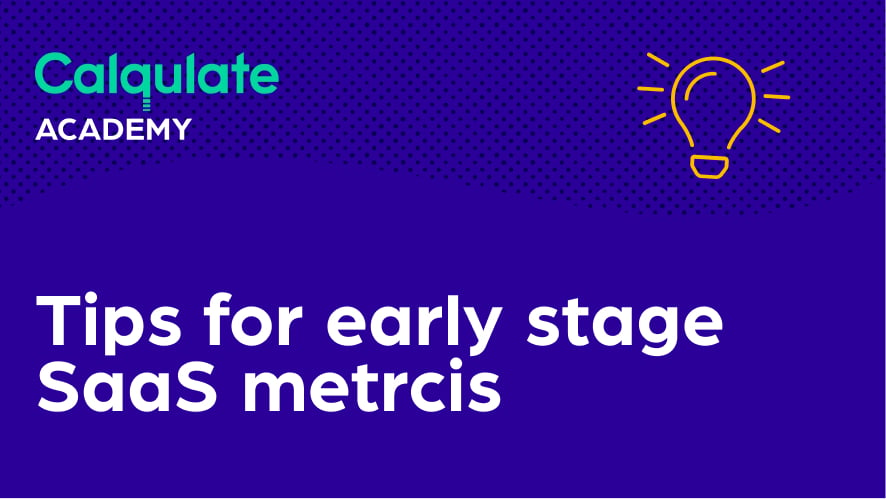SaaS and subscription metrics for very early stage companies
New SaaS startup companies that have only recently launched their software don’t have a lot of usage or subscription data due to the short history of their operations, and for that reason, only a few metrics really count in the early stages. Here are the most important metrics and key performance indicators that every early stage SaaS company needs to analyze on a regular basis.
- Number of users
- Monthly recurring revenue (MRR)
- MRR growth %
- Average revenue per account (ARPA)
Number of active users
Every new company needs users, and it doesn’t really matter in the beginning if the users are on a paid plan or have a free trial (even an extended free trial). Getting the maximum number of users is the number 1 thing that counts for an early stage company. If you have users that love your product, they will convert into paying customers at some point. Getting validation from your first customers and converting them to a paid plan means that you have a Product / Solution Fit and you are solving a problem that exists in the market.
By interviewing your first customers, you will get tons of feedback and ideas for your SaaS development roadmap and future pricing strategies. We always recommend launching the MVP and new features as soon as possible in the early stages. Do not finetune the features of your software, just launch without any delays and keep on improving your software every day.
We recommend breaking down the user base into categories:
- Free trial/paid plan
- Country
- Plan
- Currency (if you have plans in multiple currencies)
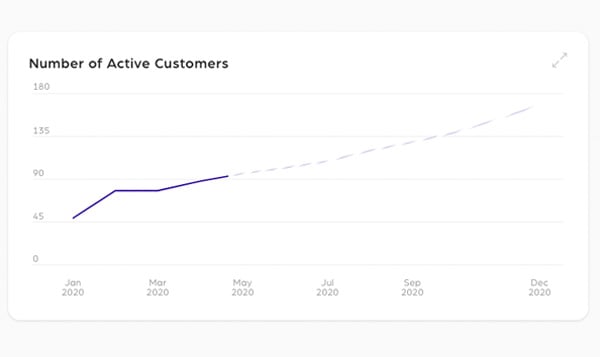
Monthly recurring revenue (MRR)
Monthly recurring revenue is scalable, and most SaaS businesses live and die by their MRR.
Monthly recurring revenue is one of the most important metrics for a SaaS company of any stage. MRR measures the predictable revenue that a SaaS company can expect to get on a monthly basis, as opposed to one-off, transaction-based revenue. Sum up the most recent values of all your subscriptions and you’ll get the total value of your MRR. For example if you have 10 customers, and they are all paying 100 USD for a subscription, your MRR is 10 x 100 = 1,000 USD.
Many SaaS companies have both recurring and one-off revenue. The amount that your customers are paying to use your software (subscription revenue) is considered as MRR, whereas onboarding fees, technical support and training services are usually considered one-off revenue, unless a customer has a monthly recurring training or technical support subscription for example. Only software-related MRR is 100% scalable though, and staff-related MRR does not infinitely scale up therefore counting less in the valuations of SaaS companies. That’s why we recommend keeping the above mentioned 3 revenue categories separate.
If customers are paying for your product, and your revenue is increasing, you are on your way building a sustainable and healthy business and can make more investments into product development and future growth of the company.
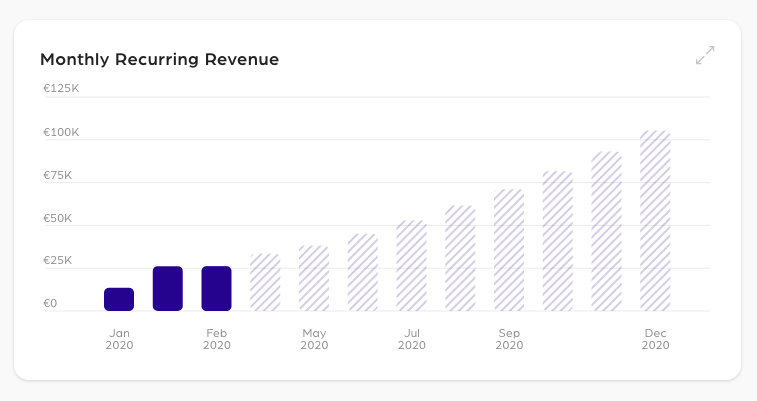
As with the number of users, we recommend breaking down the MRR into categories:
- Country
- Plan
- Currency (if you have plans in multiple currencies)
- Cohort (for example January 2020 MRR) to see the evolution of MRR between cohorts
MRR Growth %
Monthly recurring revenue growth rate % tells you how fast your MRR is growing month-to-month, and measures the monthly percentage MRR increase.
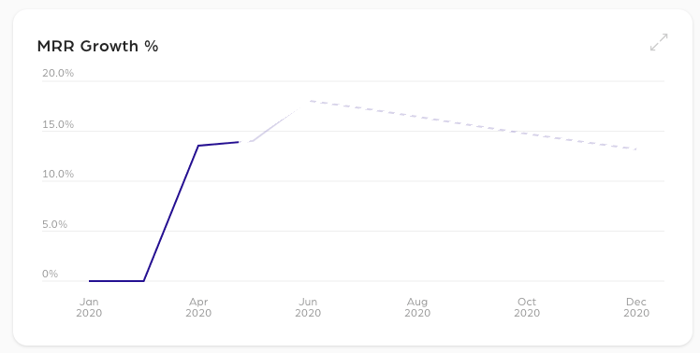
Net MRR increase takes into account the following items:
Additions:
- New subscriptions
- Add-ons
- Upgrades from one subscription to another, higher paying one
- Reactivated subscriptions
Subtractions:
- Churned subscriptions
- Downgrades from one subscription to another, less paying one
Net MRR Growth Rate % calculation:
(Net MRR at the end of reporting month – Net MRR at the end of last month) / Net MRR at the end of reporting month x 100 = Net MRR Growth Rate %
Be mindful of the fact that MRR growth % can be misleading for early stage companies as the revenue starts from zero, and the growth percentages are usually sky high in the beginning. You might encounter monthly growth rates of 100% or more in the first months, but the growth rate decreases as months pass.
Example: if your MRR grows by 15% every month, the annual growth rate is 365%. Many SaaS companies follow the mantra “triple, triple, double, double” on their path to a billion-dollar company when it comes to annual MRR growth rates.
|
Month |
1 |
2 |
3 |
6 |
12 |
|
MRR USD |
$5 000 |
$5 750 |
$6 613 |
$10 057 |
$23 262 |
|
MRR growth % |
15 % |
15 % |
15 % |
15 % |
15 % |
|
Annual growth % |
|
|
|
|
365 % |
Average revenue per account (ARPA)
The average revenue per account (ARPA, or ARPU, average revenue per user) measures the revenue generated by a single account (or user), and is calculated by dividing the total MRR by the total number of accounts. For most early stage companies, it makes sense to calculate the ARPA for new customers separately, as the pricing strategies of early stage companies are usually work-in-progress. The average revenue for new customers is likely higher than the ARPA of the total customer base, as the total customer base can also include the very first subscriptions that were likely done at a lower price.
For most SaaS companies it is crucial to see the trendline of their ARPA, and to make sure they provide more value for their customers as the product develops, and the added value drives the pricing up.
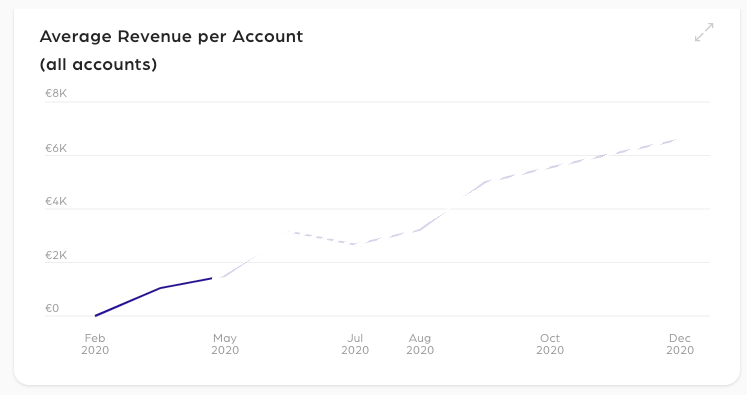
We recommend breaking down the ARPA into the following categories:
- Annual ARPA, for example 2019 and 2020
- New accounts vs total customer base
- Plans
- Country
How to use the early stage metrics in sales forecasting and cash flow forecasting?
The above early stage SaaS metrics are key elements in sales forecasting and cashflow forecasting. By forecasting the number of new customers per month, and multiplying this by the forecasted ARPA, you get the new MRR per month and can calculate the forecasted total MRR in the coming months and years. If you charge customers monthly, you can forecast the incoming subscription cash by the total MRR. If you charge annually, you can multiply the new MRR by 12.
|
Month |
30/04/2020 |
31/05/2020 |
30/06/2020 |
31/07/2020 |
31/08/2020 |
|
ARPA |
$500 |
$520 |
$540 |
$560 |
$580 |
|
New customers/ month |
4 |
5 |
6 |
7 |
8 |
|
New MRR |
$2 000 |
$2 600 |
$3 240 |
$3 920 |
$4 640 |
|
Total MRR |
$2 000 |
$4 600 |
$7 840 |
$11 760 |
$16 400 |
We will dive deeper into sales forecasting and cashflow forecasting in future articles. Subscribe to our newsletter, learn more and keep up-to-date about the SaaS metrics!
